This summer Universal Studios Hollywood is celebrating their (roughly) 5oth anniversary of studios tours and as a theme park, while the movie studio location of the park itself celebrates their 100th year. A lot of exciting stuff is happening at Universal Studios Hollywood this summer related to the anniversary, including the opening of Fast and the Furious Supercharged and the introduction of Nighttime Studio Tours, plus the new Springfield area in the upper lot we talked about earlier this month.
To get a sense of the history of the park, some details on the work preparing for the new attractions, and a hint at the future of the park, we got a chance to speak with John Murdy, Creative Director at Universal Studios Hollywood. John is best known for his role as executive producer of the annual Halloween Horror Nights, but he has also worked on dozens of other rides and shows at the park. His history with the park goes back to visiting it as a kid in the 1970s, and working as a studio tour guide starting in 1989. In addition to his role as Creative Director, he is the unofficial studio historian for Universal Studios Hollywood, so he’s a true expert on the past and future of the park.
C101: So John, when did the offering of studio tours and opening of the park actually begin?
John Murdy: “The tradition of inviting the public to step behind the scenes of the movie studio and experience that, you have to go back 100 years. That actually started march 15, 1915 when the gates of Universal Studios were first opened as a movie studio, because the president at the time, Carl Lemley, the founder of Universal pictures, the first thing he did was invite the general public to come opening weekend, walk around the movie studio and watch them film movies. They had a whole bunch of publicity kind of stunts that they planned and executed for that. That actually went on up until the late 1920s, with the advent of sound.
“The gates closed for a number of decades, and even as far back as the 1950s they used to let the tour groups that would drive around and see the movie stars homes, Gray Line Tours, on the property and hand the tour operator a script, and they would drive around the backlot. While they were doing all of that must have been the time where they came up with the idea for a permanent studio tour.
“That opened in the mid 1960s. I think there were three trams and a handful of tour guides, and then pretty quickly after the first year, in 1965 it became more formalized.”
C101: When the tour became more formalized, when were attractions like the special effects and shows added, and what was the thinking behind adding them?
JM: “You saw the attractions going back to the earliest days of the formalized studio tour in the ’60s. All studios had all the departments in house, so you would have a special effects department and a makeup department and a props department and set builders (that) all existed within the world of the studio, so even in the earliest days of the formalized tour in the ’60s they would get the special effects department to create attractions for the tour. I started coming in ’72 as a kid and even back then which was less than a decade since when they first opened, there were things like a mechanical gorilla that would swing through Tarzan’s jungle, all kinds of stuff like that. It seems to have started pretty soon after the tours started up. There are a whole bunch that aren’t here anymore, the Runaway Train, the Avalanche, the ice tunnel, a lot of those were built by the effects department of the movie studio, so it seemed like right from the get go in addition to seeing the authentic real Hollywood there was a notion to entertain the guests with the magic of Hollywood.
“Some of the earliest ones were things like the Flash Flood and Red Sea, and the Avalanche. The Red Sea and Flash Flood are still there. All these cropped up in the early 1970s.”
C101: When the studio started offering tours again and adding theme park elements, how did they let the public know that it Universal was now not just a movie studio, but was open to the public and was starting to become a theme park?
JM: “That also goes back to the earliest days of Hollywood and the movie studio. The original press release when they opened Universal on Mar 15, 1915 invited 20,000 people to see the opening celebration. (The) press release…was really interesting because the things that were mentioned in the release were all things that actually happened on the tour, which was just pure coincidence. The crux of what (studio founder Carl Laemmle) was saying was come see behind the scenes of a movie city … where you could see sets being built so they could burn them down, and floods, and disasters, and he’s going down this list and you think about the early animations on the tour and you had a burning house and a flash flood. Laemmle was way ahead of his time…with the idea that the world of Hollywood was so fascinating and captivating to people that they would want to come to a movie studio and get an exclusive chance to step behind the scenes and see how all these things were created. All of the marketing through the years was focused on originally seeing the studio tour and getting a glimpse behind the curtain of how Hollywood movies and TV shows were made, and then after as rides started to come online you’d see language like ‘ride the movies.’
“Still to this day those two things are absolutely true about Universal Studios Hollywood. There will always be the authentic movie studio tour where you’re driving past places like the real psycho house that dates back to 1960, but you also have attractions like Fast and the Furious Supercharged that put you in the middle of a movie and gives you that visceral experience that you can’t get going to a movie. It’s literally like experiencing the movie first hand, and that’s existed since the silent film era, these days it’s just a lot more technology.”
C101: When was the first ride added to the park outside of the tour?
JM: “The first was the ET ride (opened in 1991). There were always big shows and spectacles and attractions, and big things on the tour. When I started in 1989 as a tour guide it was the summer we opened earthquake and that (was) a huge modern day theme park attraction, but it was in the context of the tour. Going back before that you had things like the Conan show. When that opened it was completely state-of-the-art. It was the first time people had used lasers in that kind of capacity. It was this huge big spectacle with animatronic dragons. So those were big things you would see in a theme park, but the first ride was the ET adventure.”
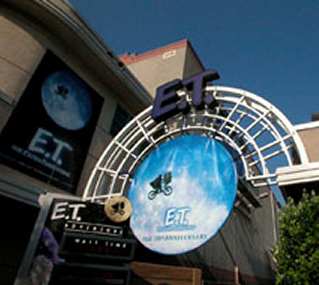
The original entrance for the E.T. Adventure, the first ride off the tour,, now home to Revenge of the Mummy (courtesy http://www.thestudiotour.com)
C101: What was thinking going into deciding to expand to other attraction outside the shows and tour?
JM: “The way the property evolved, nobody back in 1915 had a master plan, this place always evolved at the same time co-existing with the movie studio, so it’s a lot different than if you were building a Themepark anywhere else. That’s also what makes it so unique…but, you saw that even in the beginning of the studio tour, originally it was just a tour and things like the Western Stunt show weren’t even in theaters, they were set-up with bleachers on the ground. There was an animal actors show that way predates the modern one that was almost in the crowd organically. The makeup demo was in the commissarry. Eventually, pretty quickly, they started adding additional experiences in what they called the entertainment center, which is (now) the top deck of the park, and all of those were designed for length of stay. Because people would come and ride the tour, which back in the old days was probably 2.5 hours because it had a lot of elements that became stand alone attractions. Like the special effects show, (you) used to get off the tram and you’d go through the show and see it in the context of the tour. So there were these stop-off points on the tour and then eventually as the property got built out those became stand alone permanent attractions…but all of it I’m sure was people came here and they took the tour for 2-3 hours, but we had to create other attractions/rides/shows to fill out the day so it was a full day experience.”
C101: You mentioned the early elements on the studio tour, and some of the newer ones. In terms of how the park decides to upgrade elements, is there a schedule to it, or is it based on a great new idea that leads to new attractions? What changes are happening to the park now?
JM: “There’s always a plan that’s looking into the future. Some things, like take Water World for example, which is well over 10 years old, when it was originally created it created day in day with the movie release, but that show…still is the highest rated show on the property. It’s still so impressive that it’s still here, and that’s the reason, it’s because people are still blown away by that show, and we continually tweak and change it and add things to it over the years. Other things have a certain life and get replaced by other attractions. Originally where ET was that became the Mummy ride later, and those things happen at theme parks everywhere, but right now what we’re in the middle of this epic transformation of the theme park, that’s unprecedented. I’ve never seen anything to compare to what’s happening right now. We just opened Springfield…later this summer Fast and the Furious: Surpercharged is going to come online. Looking out my window right all of that being built and Harry Potter and all of this stuff happening. This is such an intense period where so much of the park is being transformed at once, not only specific attractions, but the general park itself is getting an identity, so that…what I would call the connective tissue of the theme park when you move from one attraction to another all has a uniform look and feel to it. It’s just unbelievable, probably well over a third of the park is going to look totally different in the next couple of years.”
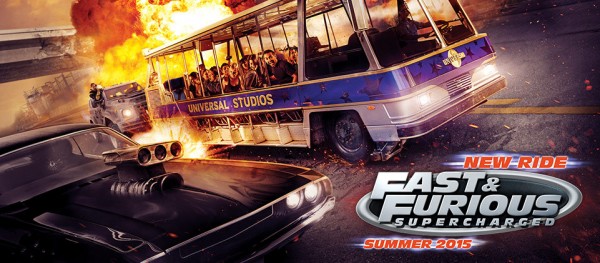
Fast and the Furious Supercharged is one of the big new attractions coming to Universal this summer.
C101: Is the transformation going on now is by far the biggest expansion the park has ever seen?
JM: “Yeah, it’s by far the biggest transformation this park has ever seen in all the years it’s been here. But there’s plenty of things planned into the future beyond that. When you’re trying to “WOW” people and thrill them and put them inside the world of movies and movie technology changes dramatically (you have to evolve).
I always think of the touchstone point of that being 1993 when Jurassic Park came out, and I consulted on that movie so I was involved in the beginning, when that movie was created suddenly all things were possible in movies. You see a trailer for a movie now and you say “oh look, they’re destroying the world again.” The kinds of things you can do in movies you just couldn’t do in the past, so as movie technology pushes and pushes into the future and creates these amazing and immersive worlds, it forces everybody in the themed entertainment industry to push those boundaries as well, so we never really stop. We’re always thinking about the next big thing and what’s coming in the future.”
C101: Do you anticipate anything as big as the change happening now happening again in the near future?
JM: “This is huge and it’s a sign of the times. Obviously there’s huge compelling attraction for people all over the world to see the place where movies are made but to also experience their favorite movies like we’ve been doing on the property for fifty year, but it continues to evolve. Looking into the future you can’t say “oh this will be the only time we do this” because it’s just changed so much, where all these things we’re creating now are these completely immersive experiences that put you in the world of the film and they’re such a higher level of detail than they were fifty years ago for sure.”
C101: Does part of the decision to update things get driven by rides that don’t work or get damaged, like when the original King Kong was damaged?
JM: “‘King Kong’ was a unique situation, but that opened the door to Peter Jackson and King Kong 3D, (we were) able to take that same property and combine it with all the technology that Peter Jackson and WETA brought to the table in making the movie.
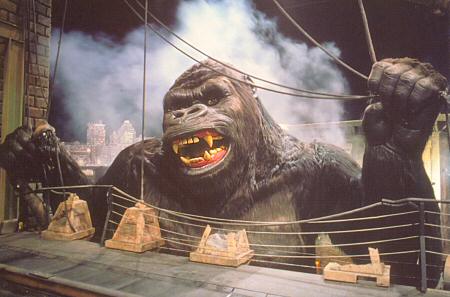
The original King Kong that was lost in 2008, but gave birth to the awesome King Kong 360 3-D in 2010 (courtesy www.thestudiotour.com).
“But it really depends, I’m working on the Night Tour right now, which is nighttime version of the studio tour that’s being created to help celebrate our 50th as well, and I’m out there with all the folks working on things like Jaw and Flash flood. Jaws has been here since the ’70s, but it’s really cool to be able to revisit those classic attractions and create different moment and different experience for them. In the case of Jaws we can focus more on the scene in the movie that took place at night when Richard Dreyfuss is diving off his boat looking for Ben Gardner’s boat, just the way the whole thing looked is something we could create for the Night Tour. So some of these experiences have been here for a long long time and will continue to be here for a long long time. The funny thing about that attraction is that the Shark is probably way more reliable than the one Spielberg used, that’s how the tour script has evolved over time and we talk about that a lot on the studio tour now. The genius of Jaws for Spielberg was that he had all these issues with the Shark and what he had to do instead was use the camera to be the Shark. We can use our mechanical Shark that’s been doing it’s thing for 30-something years as a reference point to a classic moment in time in Hollywood that changed the nature of movies.”
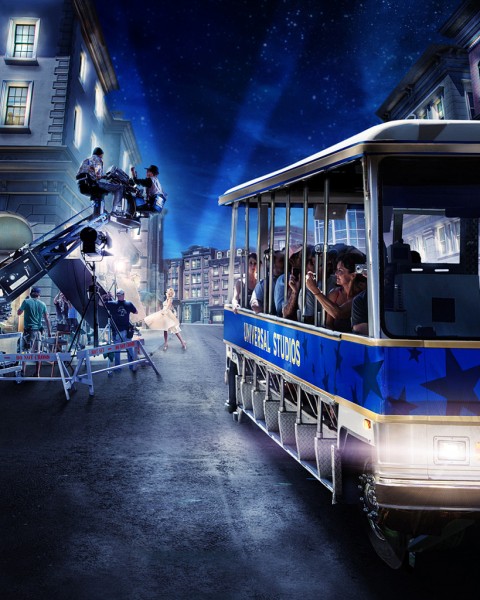
The new Nightime Studio Tour starts officially July 4th weekend, although some lucky guests have gotten on preview rides certain days at the park (courtesy Universal Studios Hollywood).
C101″ Can you tell us a little more about the working going on for the Night Tour?
JM: “You absolutely can do different things (at night) because, for example, Jaws is way more scary at night. We’ve been going around for the last over two years, first of all just lighting the entire backlot, because for all the years the studio tour has been in operation we’ve never offered tours at night. The real practical reason for that is because when you have all these sets on the backlot for movies and TV shows, when they come into film they bring the lighting with them. You don’t leave lighting up, every movie is lit differently and every TV show every shot is lit differently. So we had to work…hand in hand with the movie studio grip and lighting department because we have to light all of this for the night tour, the whole property, it’s a huge undertaking, but we have to do it in a such a way that it doesn’t impact movies and TV show filming. So for example out on the New Metro sets on the backlot where we need to have big huge moonlight washes going up and down New York street the only way to light that is from the top of the buildings, but if we put these big permanent light structures up there and somebody else comes in there and wants to film a scene then they’ll see it in the shot, so we had to design it all so it could be these retractable lights that could be raised and lowered, or in other cases they’re on sensors so they only go on when we want them to go on.
“In addition to all the lighting we’re doing a lot of video enhancements not only to the tram and the content the tour guide talks about but to the actual sets themselves. So when you go past Six Points Texas you’ll see a classic Western barroom brawl going on inside the facade, when you go past the psycho house you’ll see the silhouette of mother walking back and forth in front of the door and you’ll hear the classic monologue from the end of the film. In the case of Jurassic Park where we have the original set-pieces from those movies, there’s a mobile lab out there from the second Jurassic Park movie and we’re showing technicians being attacked by spitters and raptors in fully rendered CGI. So we’re adding a lot of that and we’re also adding some live encounters so you get to encounter sort of classic hollywood moments in the locations where they were filmed, whether it’s Norman Bates at the psycho house or Frankensteins Monster in Little Europe where the Horror movie was invented. There’s a whole bunch of different elements so that hopefully at the end of the day it feels like an all new tour.”
C101: Lastly, think you could share any good celebrity anecdotes from the tour’s history?
JM: “Jim Carey, I remember that, that was hysterical. Literally we had no idea that he was up there that day. He was doing a movie called Man on the Moon, playing Andy Kaufman, and Andy was famous for these stunts he would do, so I’m sure Jim’s thinking was that he was trying to get into the spirit of Andy and wanted to do something like that, so he was literally dressed as mother up a the psycho house. The funny thing is there were all these people that had that encounter and they probably had no idea that it was Jim Carey. There’s been many, many, many other cases over the years. Eddie Murphy, when he was doing nutty professor and Rick Baker was doing his academy award winning makeup for it, when they were first working on that he wanted to test out Grandma Clump, so he did that in the area where the old special effects stage show was for the tour. So he’d just walk up to tourists and ask them for where the bathroom was or directions or whatever, and when he realized nobody was recognizing him he knew that he could pull it off. But all through the history of the tour there have been those kind of one-time encounters with stars. I’ve talked to stars and worked with people that have told me they went out of their way to be seen by the tour. A good example is Jason Alexander from Seinfeld, he got his start on the lot when he was just a Broadway actor and was doing a TV show called E/R (a short lived comedy, not the long lived drama). I was working with Jason one day and he told me ‘you know when I was doing this TV show and I was an up and coming actor I would intentionally have lunch over by the Psycho house every day in the hopes that someone on the tram would recognize me.’
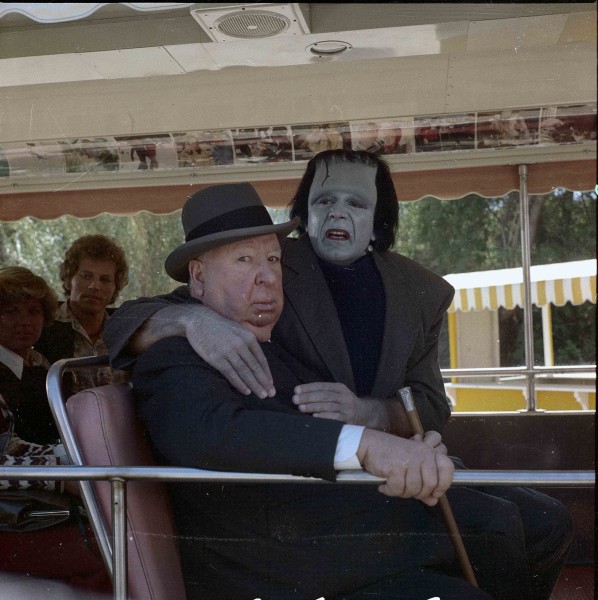
Sometimes famous Hollywood figures just go for rides on the tour (courtesy Universal Studios Hollywood)
“I’ve had directors call me up and say ‘hey I just did this movie and I have this cool prop, would you put it on the tour?’ And I’ll ask them why and they’ll say, ‘because then I can tell my parents I made it in Hollywood.’ The director of U571 literally called me one day and said, ‘hey can I give you the miniature sub from the movie, can you put it on the tour somewhere?’ It was on the tour for many years, now it’s in the archive. Ron Howard told me years ago that whenever he was on the lot he would make a point driving down (the road with the movie posters) just so he could see his movies like Appollo 13 and Beautiful Mind. It just made him proud that his movies were alongside some of the greatest movies ever made there. It means a lot to them.”
Many thanks to John for speaking to us about the history of the park, and about some of the work they’re doing on the new attractions coming up this summer and next year. The new Nighttime Studio Tour actually started doing surprise preview rides to guests earlier this week as it’s currently testing, and you can find an early review of it at Behind the Thrills, including seeing some of the new effects John talked about here. The tour will officially run from July 4 to Labor Day, but if you’re at the park earlier, you can check to see if they’re running. Fast and the Furious: Supercharged will be opening on June 25, and of course the Wizarding World of Harry Potter is opening in 2016 (which will have some big announcements coming soon). Stay tuned for more on what’s happening at Universal Studios Hollywood coming up, and again many thanks to John for sharing so much great history (and details about the new things coming to the park) with us!

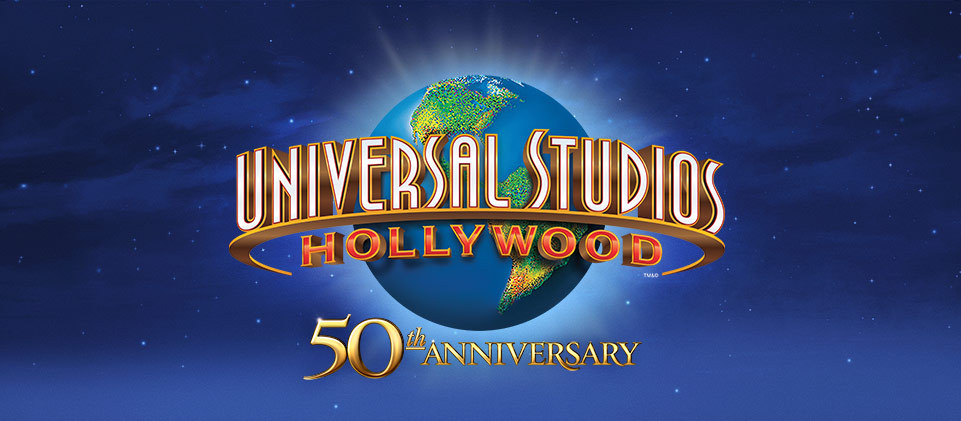
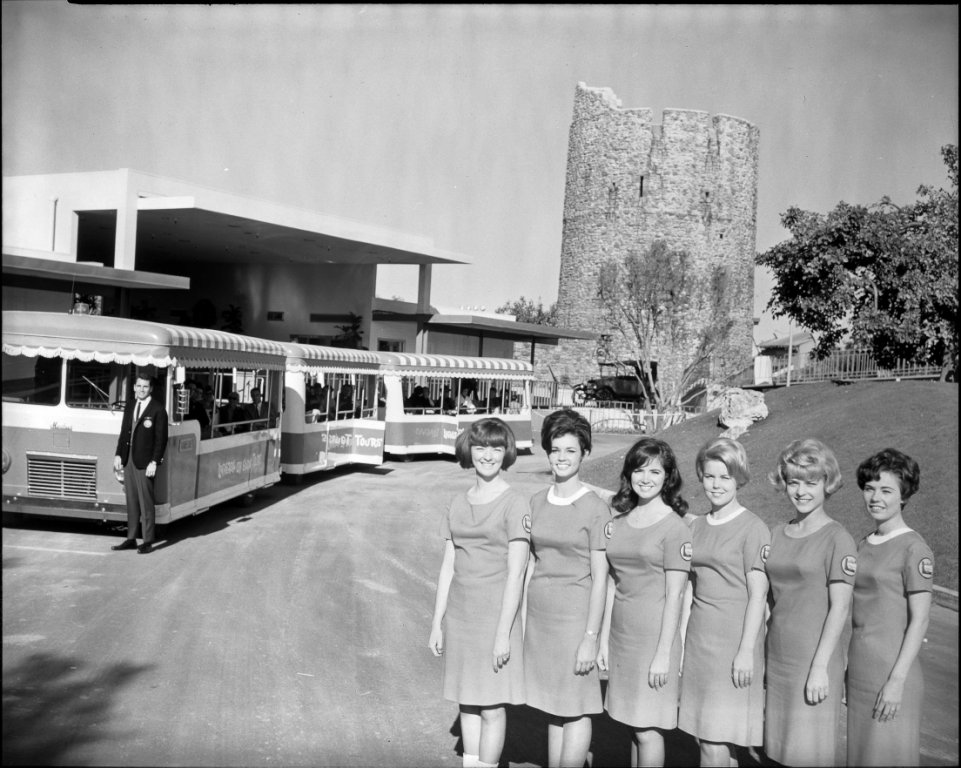
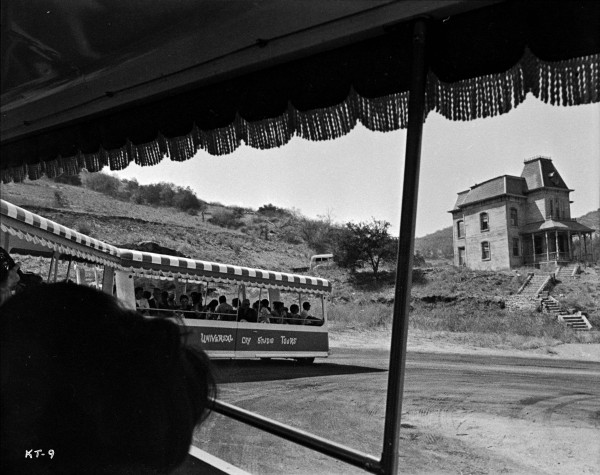
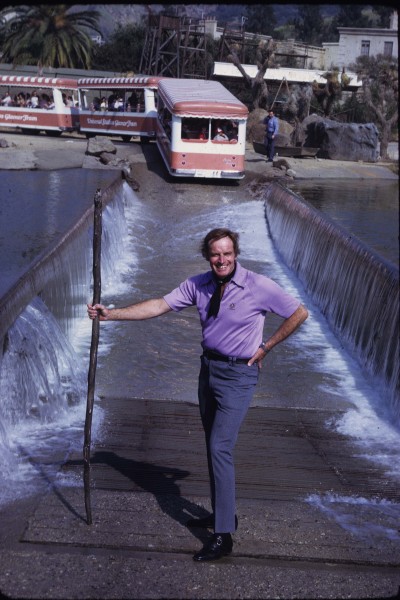
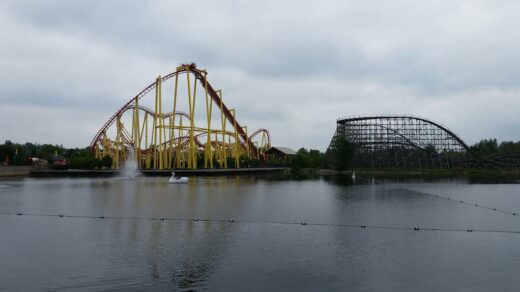

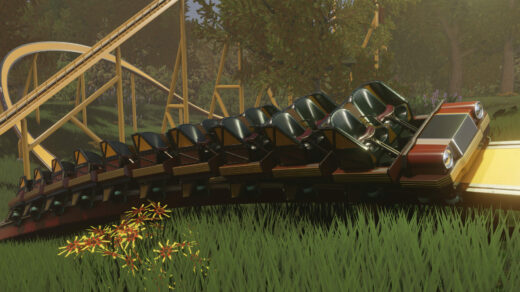





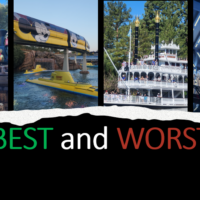




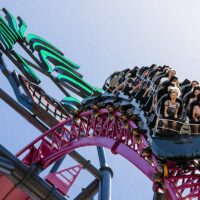
OUTSTANDING JOB !!THIS STORY BROUGHT BACK A LOT OF MEMORIES FOR ME , I used to Volunteer to help a Help a Handicapped Friend of mine to Detail K.I.T.T. on the KNIGHT RIDER Attraction when it was still at Universal the last time in 1993. To show their appreciation THE KNIGHT RIDER HISTORIANS ,Made me a You Tube Page with the video of the last time I worked on Him KEEP UP THE GREAT WORK AND ENJOY THE VIDEO Jake